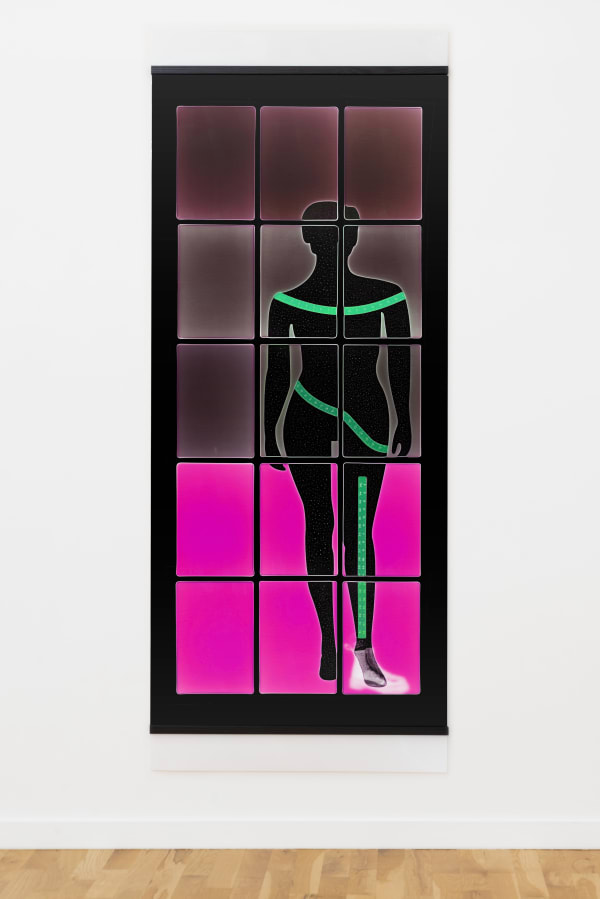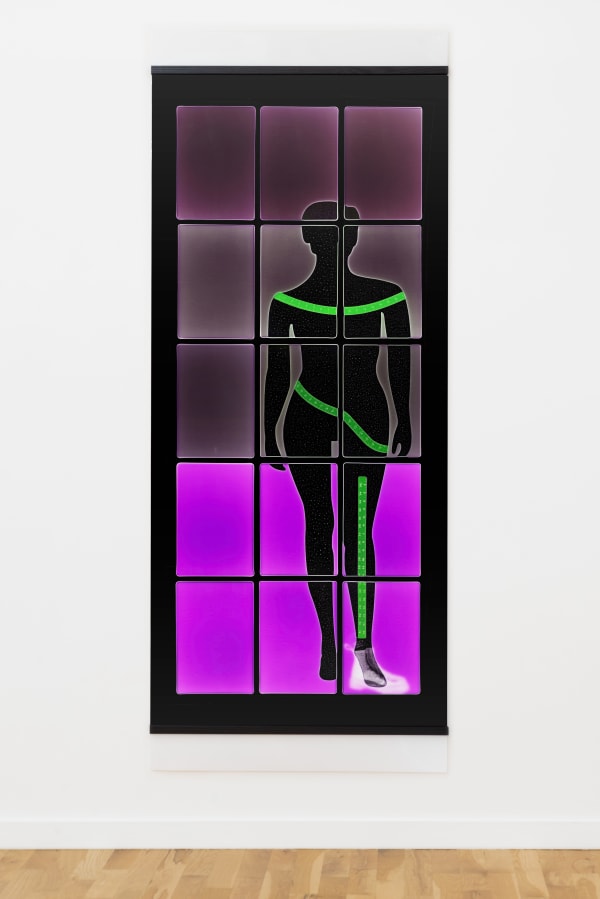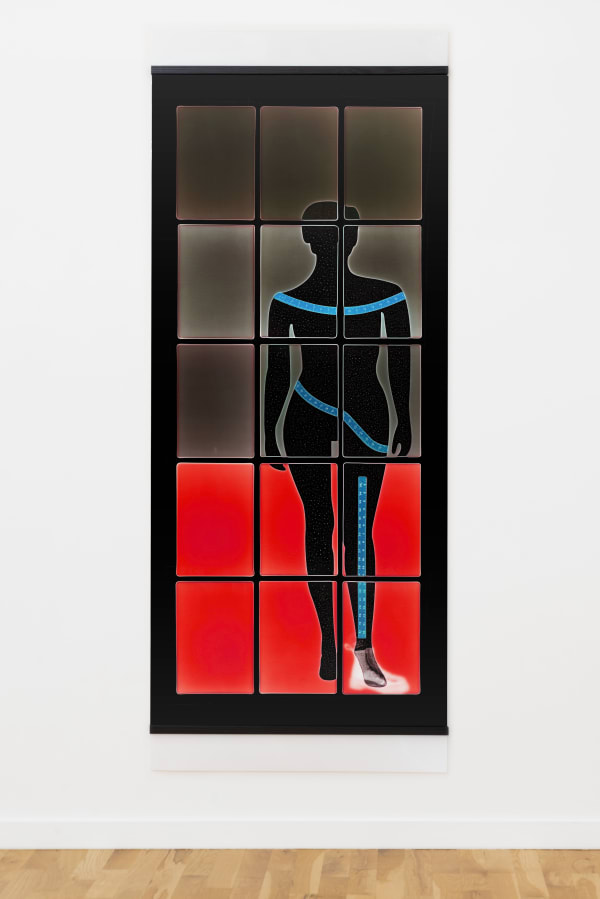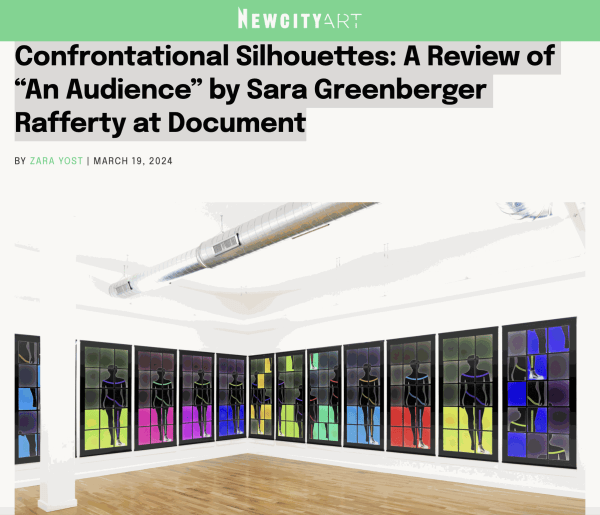An Audience: DOCUMENT, Chicago
-
 Glass Figure One – I Don’t Give a Fuck, 2023Fused and kilnformed glass, and hardware73 x 32 x 1/2 inches
Glass Figure One – I Don’t Give a Fuck, 2023Fused and kilnformed glass, and hardware73 x 32 x 1/2 inches -
 Glass Figure One – Lens Line, 2023-2024Fused and kilnformed glass, and hardware73 x 32 x 1/2 inches
Glass Figure One – Lens Line, 2023-2024Fused and kilnformed glass, and hardware73 x 32 x 1/2 inches -
 Glass Figure One – Nighttime, 2022-2023Fused and kilnformed glass, and hardware73 x 32 x 1/2 inches
Glass Figure One – Nighttime, 2022-2023Fused and kilnformed glass, and hardware73 x 32 x 1/2 inches -
 An Audience (Blue Variation), 2024Laminated Inkjet print80 x 36 inches (203.2 x 91.4 cm)
An Audience (Blue Variation), 2024Laminated Inkjet print80 x 36 inches (203.2 x 91.4 cm) -
 An Audience (Lime Green), 2024Laminated Inkjet print80 x 36 inches (203.2 x 91.4 cm)
An Audience (Lime Green), 2024Laminated Inkjet print80 x 36 inches (203.2 x 91.4 cm) -
 An Audience (Pink), 2024Laminated Inkjet print80 x 36 inches (203.2 x 91.4 cm)
An Audience (Pink), 2024Laminated Inkjet print80 x 36 inches (203.2 x 91.4 cm) -
 An Audience (Light Purple), 2024Laminated Inkjet print80 x 36 inches (203.2 x 91.4 cm)
An Audience (Light Purple), 2024Laminated Inkjet print80 x 36 inches (203.2 x 91.4 cm) -
 An Audience (Purple), 2024Laminated Inkjet print80 x 36 inches (203.2 x 91.4 cm)
An Audience (Purple), 2024Laminated Inkjet print80 x 36 inches (203.2 x 91.4 cm) -
 An Audience (Yellow Variation), 2024Laminated Inkjet print80 x 36 inches (203.2 x 91.4 cm)
An Audience (Yellow Variation), 2024Laminated Inkjet print80 x 36 inches (203.2 x 91.4 cm) -
 An Audience (Lime Green Variation), 2024Laminated Inkjet print80 x 36 inches (203.2 x 91.4 cm)
An Audience (Lime Green Variation), 2024Laminated Inkjet print80 x 36 inches (203.2 x 91.4 cm) -
 An Audience (Green Variation), 2024Laminated Inkjet print80 x 36 inches (203.2 x 91.4 cm)
An Audience (Green Variation), 2024Laminated Inkjet print80 x 36 inches (203.2 x 91.4 cm) -
 An Audience (Blue), 2024Laminated Inkjet print80 x 36 inches (203.2 x 91.4 cm)
An Audience (Blue), 2024Laminated Inkjet print80 x 36 inches (203.2 x 91.4 cm) -
 An Audience (Red), 2024Laminated Inkjet print80 x 36 inches (203.2 x 91.4 cm)
An Audience (Red), 2024Laminated Inkjet print80 x 36 inches (203.2 x 91.4 cm) -
 An Audience (Yellow), 2024Laminated Inkjet print80 x 36 inches (203.2 x 91.4 cm)
An Audience (Yellow), 2024Laminated Inkjet print80 x 36 inches (203.2 x 91.4 cm) -
 An Audience (Purple Variation), 2024Laminated Inkjet print80 x 36 inches (203.2 x 91.4 cm)
An Audience (Purple Variation), 2024Laminated Inkjet print80 x 36 inches (203.2 x 91.4 cm)
The installation presents a series of large-scale reliefs, female silhouettes composed from panels of kiln-fired glass fused with photographic images, alongside unframed contact prints, a method of cameraless photography that stages various permutations of the wall-based sculptures through form and color. Spanning the gallery walls to compose a frontal line, the works on view invoke a crowd of inanimate bodies—reminiscent of discarded mannequins, life-sized diagrams transposed from anatomy textbooks, forensic crime scene outlines or autopsy reports—a collection of anonymous and enigmatic figures of display. While the figure remains consistent throughout each work, different objects occupy the body or its surrounding field: magnifying glasses, yardsticks, sardines, an eyeshadow palette reminiscent of color checkers used in studio photography, among other items. Across these disparate markers, each exists as a unit of measurement, of how closely things can be observed or arranged in proximity to our eyes or one another.
The exhibition features Rafferty’s ongoing investigations into understanding how contemporary life is assembled through images—not in linear fashion or sequentially, but all at once. Her subjects are conveyed through iconography, an approach to representation that denies a spatial environment in favor of the flatness embraced by glyphic signs and symbols. Across Rafferty’s installation, three-dimensional space is not being collapsed into two dimensions, but created from it.
Vacant of details that describe the body, the artist’s expressionless selves creates a procession of uncanny portraits. In Glass Figure One – I Don’t Give a Fuck (2023), the translucent figure stands against a milky backdrop of powder pink, lavender, and pale blue. A pliant measuring tape, such as one a seamstress would use, encircles her shoulders and hips, while a rigid ruler is situated firmly on her shin. From this relief arises a series of codified incarnations—at times the tiles that compose the figure are assembled in the same order to create contact prints, in others rearranged into configurations that deconstruct the body across the gridded framework. Amid the unframed, glossy sheets that hold these pictorial echoes, we see the imposing presence of an afterimage in primary hues of red, yellow, and blue. The spectral presence of Rafferty’s bodies are collapsed into shallow fields of black where the original material used to cast the negative image is made more visible. While subtly perceptible in the reliefs, the inverse photographs accentuate the proliferation of tiny air bubbles embedded within the glass panes—the x-ray like reproductions create a field that appears like stars in the night sky.
Across her practice, Rafferty has been persistently engaged with the grid, a ubiquitous standard of organization in our physical and digital worlds, as a means for categorizing collections of material culture and data as well as a method of control, surveillance, and limitation. The recurrent life-size scale of the artist’s lifeless subjects has manifested in past work through stand-ins of gendered garments: images of dresses, bodysuits, shapewear, and pantyhose. This is a feminist project—in place of the corporeal, Rafferty depicts the female body as a socially constructed vessel built to contain ideals through the transposition of projections and inanimate things.
Read as references rather than realities, An Audience underscores the history of how figurative language operates in relation to text and image. In addition to a form, the ‘figure’ also expresses the anatomy of images—a word that borrows the terminology of the human body to describe where reproductions appear in manuscripts. In the expanded footnote of an essay by poet Lisa Robertson published in the artist’s 2022 experimental monograph Sara Greenberger Rafferty: Studio Visit, the author chronicles the etymology and history of the use of the term: “an object or image figures when it receives more of our imaginative projection that its social or mythic function would require,”[1] (my emphasis). For Robertson, ‘figure’ is both a noun and a verb whose meaning stands in opposition to the symbolic. The figural relates to an interpretation of history, while the symbol interprets life. Yet, the function of these two forms are evenly quoted in Rafferty’s work, in An Audience more so than previous exhibitions—punctuated by isolated scanned images, the quotation of objects and bodies are collapsed into a single icon.
As much as the photographic origins of Rafferty’s work provide a context of how her images are read, the artist’s medium can be seen as exhibition-making itself. Following the artist’s past presentations at the gallery, Dead Jokes (2016), The Laughter (2018), and Views from Somewhere (2021), what can be seen as the subsequent chapter here serves as a continuation of the themes at the core of each project—tracing the ongoing impositions societal systems reign upon women’s bodies. The artist’s viewpoints are inextricably tied to material culture and unfold parallel to our current political landscape, each marked by pivotal moments of mass attention: Rafferty’s first show opening just two days after the Presidential election of Donald Trump, the second surrounding the U.S. Supreme Court Hearing of Brett Cavanaugh, and the third in the wake of the pandemic. Yet, in An Audience, we find ourselves reeling in the uncertainty of a world defined by unlearned lessons. This transitory, ambiguous character finds itself reflected in Rafferty’s audience, a vague and indeterminate assembly of spectators that we look at (as photographs) or through (as material). Of course, it is implied that they are the ones watching us. For precisely what and why is up for debate—nonetheless, the artist’s figures invite us to consider the desire to interpret any signification that relates to ourselves, no matter the purpose.
— Stephanie Cristello
Artist Sara Greenberger Rafferty has been engaged in work, research, and teaching largely around what she calls ‘comedy as artistic strategy.’ That is, taking aesthetic and thematic cues from comedians to create artworks that are informed by the aesthetics and practices of humor, but may not be funny. She uses tropes and stereotypes of comedy – repetition, hyperbole, thwarted expectations, undercutting, doubling, slapstick – to emphasize the individual in the group, and call upon an already both awkward and confident social body. In materiality and installation, she refers to monitors, technological products, embodiment, and the physicality of seemingly disembodied pictures as they traverse the digital landscape.
Taking inspiration from expanded photography practices, she creates wall work, sculpture, and installation. She simultaneously crafts strong handmade and machine-assisted objects while eschewing dominant notions of masterful craftsmanship.
In her career she has mounted over twenty solo exhibitions at museums and galleries around the world, including four at DOCUMENT, Chicago. Her most recent institutional solo exhibition, Forum 85, was presented at the Carnegie Museum of Art at the end of 2021. In 2014 she was included in the Whitney Biennial, and her first solo exhibition was presented at MOMA/PS1 in New York in early 2006.
Her work is included in the collections of the Solomon R. Guggenheim Museum, New York, NY; the Museum of Modern Art, New York, NY; the Whitney Museum of American Art, New York, NY; the Yale University Art Museum, New Haven, CT; the New Britain Museum of American Art, New Britain, CT; the Carnegie Museum of Art, Pittsburgh, PA; the University of Chicago Booth School of Business, Chicago, IL; and the Hood Museum of Art, Dartmouth, Hanover, NH and dozens of private collections.
She is currently Professor and Director of Graduate Studies in Photography at Pratt Institute in Brooklyn. Studio Visit, Rafferty’s recent experimental monograph, was published by Inventory Press in fall 2022.
[1] From the footnote of the first appearance of “figure” in “Time in the Codex” by Lisa Robertson, Sara Greenberger Rafferty: Studio Visit (Los Angeles: Inventory Press) 2022. 215.































